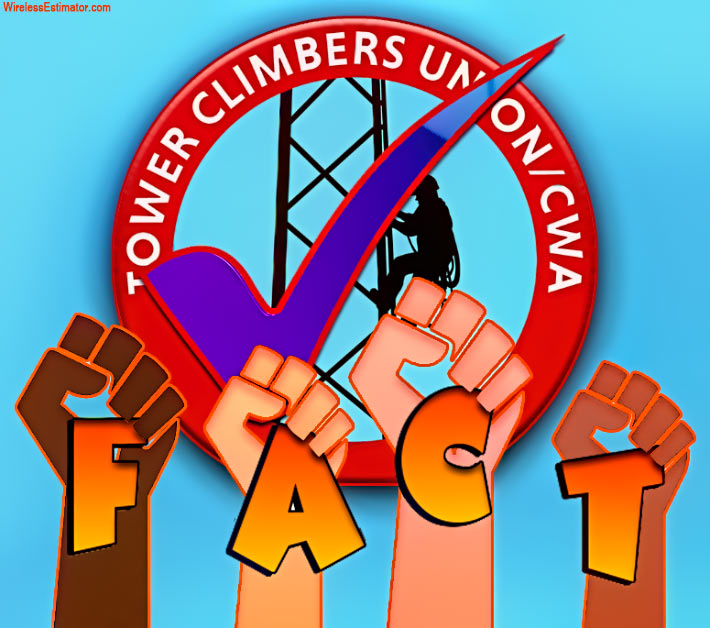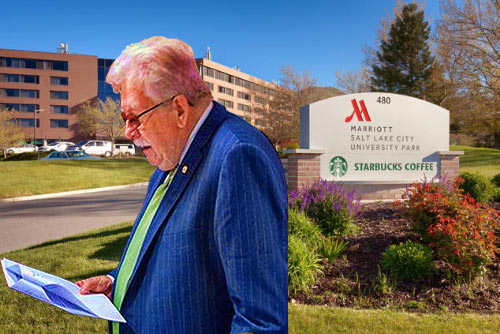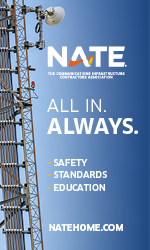
FACT CHECK ON FATALITIES AND INJURIES – Seven industry consultants, subject matter experts, and safety professionals reviewed the CWA’s survey and found the questions to be leading, too confusing, open-ended, and possibly designed to align with the union’s frequent statements that there are serious safety concerns within the industry that is comprised largely of smaller contractors.
The Communications Workers of America’s (CWA) Tower Climbers Union published the results of a survey designed by tower technicians Thursday with critical findings showing that their members’ safety is being compromised. The press release announcing the study said more than 65% of technicians have been on a job site where someone has been injured and 4% where someone has been killed, a horrific life-shattering experience.
They say the survey represents the industry at large.
NATE, WIA and CTIA, and three of the nation’s largest tower owners have declined to comment on the survey; however, a focus group of seven industry safety trainers, subject matter experts, and consultants reviewed the findings for Wireless Estimator and found the answers to be more anecdotal than statistically relevant. In addition, they found that some of the questions lead to a desired outcome in some instances and were confusing in others.
A high percentage of workers witnessing a death questioned
An overriding concern was the CWA’s assertion that 4% of tower technicians had seen a coworker killed on a job site.
CWA identifies for their survey that there are 29,000 tower technicians. Therefore, it should be extrapolated as an industry average that 1,160 technicians have been on a wireless project where they witnessed a crew member’s death.

A SALT LAKE CITY CALL FOR ACTION – Tower Technicians with the CWA’s Tower Climbers Union will rally outside Verizon’s shareholder meeting on Thursday, May 11, at the Salt Lake City Marriott to call out the telecom giant for shirking responsibility for increasing worker injuries and even deaths. They’ll be joined by CWA leaders, allies, and elected officials from across the state, as they demand a meeting with Verizon executives to discuss their rights on the job and the need for improved working conditions and safety standards. They’ll also be calling attention to their recently released survey. It is unknown if CWA President Chris Shelton will attend. He is retiring in July and is expected to be replaced by CWA Secretary-Treasurer Sara Steffens, who he endorsed in February.
Since the average crew comprises 3.5 technicians, there should have been approximately 331 industry deaths if 4% of techs witnessed a fatality. However, according to Wireless Estimator’s fatality database, which the CWA said it used to summarize its findings, since 2003, there has been less than half that count with 166 fatalities over 25 years.
In addition, the five-month CWA survey with 103 participants identified that the average respondent had been in the industry for approximately five years, during a period with 28 fatalities; therefore, almost 92% less than the amount of CWA’s alarming claim.
QualTek Services’ Henderson, Nevada, office, comprised of approximately 12 tower technicians, last year became the only tower climber group to win formal union representation in the CWA.
It is unknown if some survey respondents were on the tower crew when a 24-year-old Las Vegas technician fell to his death while employed by BACOM, a QualTek subsidiary. The BACOM death could have inflated the 17% of respondents who said they “have known someone who was fatally injured on the job.” Using the baseline of 29,000 elevated workers, the study suggests that almost 5,000 technicians personally knew one of the 28 decedents.
High job site injuries works as an article lead but not for an analysis
Quoting the CWA in their lead paragraph, Communications Daily wrote: “More than 65% of wireless tower workers have been on a tower site where someone has been injured…”.
The CWA said that instead of relying on government statistics, they used the survey and found the 65.3% injury response “shocking.”
Reviewers, however, said the yes or no question was misleading since no parameters were set to identify what constituted an injury.
A minor cut from a galvanized spur requiring a band-aid or even a few stitches or multiple bee stings might have been considered an injury by respondents. Still, according to OSHA, an incident is not reportable as an injury unless it requires one or more days away from work.
Almost 80% were concerned about safety hazards outside of their control
The CWA said that a significant concern of technicians was about the many hazards that lie outside of their control, and more troubling was they encounter those hazards regularly.
The survey asked: “Have you ever encountered safety hazards on a job that were out of your control (ie, you are pressured or forced to work in unsafe weather conditions.” It asked for examples. Although the survey only allowed for a yes or no answer, somehow the CWA identified that “54.7% encounter these safety hazards’ some of the time’ and 25% encounter these safety hazards’ all’ or ‘most of the time.'”
According to the survey’s reviewers, influences outside of a technician’s control are typically environmental such as snakes in cabinets, wasp nests, and other wildlife concerns, as well as unpredictable human influences, such as employee conflicts, irate landowners, and people using cell towers for target practice. Another significant impact out of the worker’ control is when they are traveling in a motor vehicle.
Towercos accused of frequently creating or ignoring hazards on their sites
The survey pointed out that tower owners had rules on their sites “that can cause safety concerns or hazards.”
However, it’s being questioned how tower techs, the survey respondents, could identify the suggested survey concerns that rely on engineering expertise.
For example, 60.4% of respondents said the “tower needed structural modification before my assigned job can be safely done.” Although, on occasion, an installation is scheduled before a modification has been completed, it occurring almost two-thirds of the time strains credulity, according to safety professionals.
Another questionable assertion is that 47.3% of tower techs said, “The weight of the equipment installed on the tower is more than the tower was designed to handle.”
All reviewers said they find it difficult to reason that almost half of all tower techs have reviewed the engineering design of all the towers they climb and identified dangerous structural loading.
They also said that the survey’s statement that 56% of techs said that they had witnessed structures where “there was no anchorage point, or there was no access to an anchorage point because it was blocked by equipment or another reason” was reasonable because there are instances to support that claim.
Nonetheless, they said it can be safely mitigated by using temporary anchorage points.
Survey’s insurance claims called into question
Under “Holes in Employment Rights and Insurance Safety Programs,” the survey said 31.4% of employers do not provide short-term disability insurance. However, that appears to be a plus for the industry since, according to the Bureau of Labor Statistics, in 2022, 64% of private industry workers didn’t have access to short-term disability insurance.
The CWA survey said 11.7% of companies employing tower technicians do not carry mandatory workers’ compensation insurance. However, the survey then states that 11.4% of the respondents were hired as 1099 independent contractors, which doesn’t require the employer to provide workers’ compensation insurance.
Is it a safety training wish list or instruction that isn’t required?
Although the survey says that specific types of safety training are not widely available, implying that the industry is failing to provide the necessary training for its tower techs, some of the instruction is unnecessary depending upon the individual’s assigned duties, such as operating a personnel hoist. In addition, respondents did not state they needed it; they didn’t check off the training item because they hadn’t been trained for that entry.
The survey said 22.9% of respondents did not receive training on the “use of safety kit/rescue bag.” One reviewer said that any time you have employees working at height, a rescue plan to safely retrieve a person must be implemented in advance. He explained that there is no requirement for a rescue bag or kit, but if a contractor chooses to use that method for a rescue, they must meet the training requirements of the components in the rescue kit since there are many kinds available. The recommended goal for rescue subject contact is less than six minutes, per ANSI Z359.2-6.1.
Another reviewer said that refresher training must occur at least every two years for the authorized rescuer to stay current with fall protection and rescue educational requirements per ANSI, and since the average elevated work experience of the respondents was five years, they should be trained and aware of proper rescue requirements.
Over 52% said they did not receive training on ladder safety systems. However, it is one of the first things a new climber is typically taught in an Authorized Climber/Rescuer course by training companies that certify that the employee has met the essential criteria for accepted safety and health practices per standards and the NATE CTS. Personal fall arrest systems, fall restraint techniques, and fixed ladder usage are basic subjects taught to be authorized to be on an elevated structure.
Almost three-quarters of the respondents said they did not receive gin pole training. However, since approximately only 10% of contractors use gin poles, there appears to be an adequate number of technicians already trained.
Is the CWA the practitioner of ‘fuzzy math’?
CWA concludes that tower technicians consistently fall among the top ten most dangerous occupations, and “industry apologists using fuzzy math have spread misinformation about fatality rates.”
However, their calculations are incorrect, and their summary is at odds with the statistical data from Wireless Estimator they use for their analyses.
CWA shows a 5-year fatality average of 5.6 deaths, stating that the industry has 19.3 fatalities per 100,000 full-time workers, based upon approximately 29,000 employees that work on elevated structures, resulting in being among the top 10 most deadly occupations in the country.
However, in 2021, the latest full year compiled by the Bureau of Labor Statistics, only the top eight highest fatality occupations were identified. The lowest was underground mining machine operators, with 26.7 deaths per 100,000 workers.
In addition, the CWA is aware that the workforce has been estimated at approximately 36,000 workers, and in 2021, wireless workers were one of the safer professions in the nation, with a rate of 10.8 deaths per 100,000 full-time employees based upon four fatalities in 2021, not 19.3 per 100,000 as they claim. In 2022, there were only three deaths, and that rate dropped down to 8.4, 250% lower than the lowest fatality ratio.
Entering month five of 2023, there have been no fatalities, a statistic welcomed by the industry but likely abhorred by CWA because it doesn’t fit their narrative.
Tower Climbers Union takes on tower owners and carriers
The Tower Climbers Union is promoting a petition to hold carriers and tower owners responsible for the deteriorating wages and safety conditions facing tower technicians.
They said both groups are using layers of contracting to push down wages and further deteriorate their working conditions.
In an open letter to CWA President Chris Shelton, announcing the survey results, they said their membership works for over 45 companies and resides in more than 20 states.
They said that 98.9% of the survey’s respondents indicated that wireless carriers impose rules or work requirements that can cause safety concerns or hazards.
“As we peel away the layers of this contracting scheme, we find seven companies at its core: AT&T, Verizon, T-Mobile, Dish Network, American Tower, Crown Castle, and SBA Communications. From this day forward, we are going to organize and fight until they take full responsibility for our labor, because we deserve more,” their letter read.
Two CWA tower techs register their concerns about pressures, wages, and working conditions
In releasing the survey, the CWA provided comments from two technicians who have worked in the industry for at least ten years.
“I have one of the most interesting jobs in America, but it’s also one of the most dangerous. I’ve worked in extreme wind, at night when it’s hard to see two feet in front of me and in freezing temperatures, all while hundreds of feet up in the air,” said Ryan Dupal, a tower technician of 10 years and member of the Tower Climbers Union/CWA. “Despite the essential work that I do, my safety and well-being is of little concern to the major telecom companies who profit off of my work. By hiring workers like me through contractors, telecom giants like AT&T and Verizon are attempting to avoid responsibility for what happens to us on the job. That’s why tower technicians across the nation are organizing together to demand the safety standards, working conditions and fair wages that we deserve.”
Tommy Schuch, a tower climber, foreman, trainer and rope access technician of 12 years and member of the Tower Climbers Union/CWA, said, “As a worker in the telecom industry, I help connect thousands of people, family and businesses across the country. I love my job, though there are risks that come with this line of work. That risk is exacerbated by major telecom corporations, placing us in situations that remove our ability to speak up on safety issues that arise on job sites. The mentality in this industry of ‘If you do not get the job done, we will find someone that will’ has to stop, when it comes to our safety. Our work days typically last 12 to 15 hours and sometimes up to 20 or more hours. Meanwhile, we’re facing increasing pressure to meet unrealistic deadlines enforced by the very wireless carriers and tower owners who refuse to be held accountable for our safety. It’s time these carriers stop putting us directly in harm’s way and start imposing common sense safety standards on the job.”















